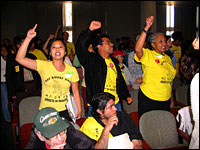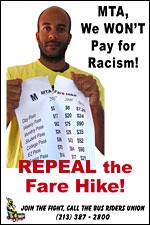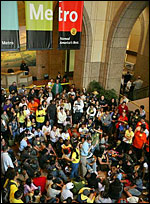A Latina woman addresses the board of the Los Angeles Metropolitan Transportation Authority (MTA). She is part of a crowd of 1,500 people opposing the agency’s proposed bus-fare increases. She holds her 3-year-old child up to the board and says, “What would you like me to do? Take the clothes off his back or the food out of his mouth?”

L.A., with 10 million people and 7 million cars on the road, is the freeway capital of the U.S. For more than 14 years, the MTA on one side and the Strategy Center and Bus Riders Union (BRU) on the other have been fighting over the future of L.A.’s public transportation — a fight with important implications for the future of the environmental movement. The heavyweight bout has grown more high-profile this year. Despite massive opposition, on May 24, 2007, the MTA board of directors voted to raise the daily bus fare from $3 to $5 a day and the cost of a monthly bus pass from $52 to $62 a month. This is just the first step in a draconian trajectory that will, if not stopped, push the monthly bus pass to $75 and then $90, force many low-income people off the buses, and compel people to use or buy old cars instead of taking public transit. These policies will increase toxic air pollution and greenhouse-gas emissions, and make the bus riders poorer while making rail contractors richer.
The fight over the fare hikes has become a cause célèbre. The Bus Riders Union and the Natural Resources Defense Council (NRDC) are in state court trying to reverse the fare hikes on environmental grounds. The BRU is also in front of the federal courts asking for a five-year extension of a federal civil-rights consent decree controlling MTA actions. Dozens of BRU organizers are on the buses, talking to thousands of bus riders, holding community meetings to plan our next countermove. The fight to reverse those fare increases, buy more buses, and stop future money-sucking rail projects is far from over. This dramatic expansion in the breadth and impact of the environmental movement in L.A. could be a model for urban coalitions throughout the U.S.
The Backstory
The MTA board has 13 unelected members who get the job, and control of a $3-billion-a-year budget, by dint of having won other elected offices — and who operate like a royal court. It includes all five members of the L.A. County Board of Supervisors, four members of the League of Cities, and Los Angeles Mayor Antonio Villaraigosa and three of his appointees. The MTA’s primary customers are 500,000 daily bus riders — 58 percent Latino, 22 percent Black, 8 percent Asian/Pacific Islander, and 12 percent white. More than 60 percent are women, and more than 75 percent have family incomes ranging from $12,000 to $20,000 a year. These are the hotel and restaurant workers, the domestic and service workers, the security guards, Korean and Jewish grandmothers, the elderly, the disabled, the students going to high school and community college — the low-income working class of color, the salt of the earth. These are the core constituents of the Bus Riders Union, which was born in 1992 with the audacious slogan “Billions for Buses.”
The MTA has fought tooth and nail against investing in the bus system that so many of the city’s residents depend on, preferring instead to build costly and little-used rail lines to serve the wealthier suburbs and a coterie of contractors and contributors. In 1994, the MTA tried to pay for its wasteful, over-budget train lines — corporate development projects masquerading as transportation — at the literal expense of the bus system. They voted to raise the daily bus fare from $1.10 to $1.35 and eliminate the $42-a-month bus pass altogether. This could have created chaos for low-income bus riders, some of whom take 100 rides a month; it might even have priced them out of public transit altogether. The BRU countered by initiating a civil-rights lawsuit charging the MTA with violating Title VI of the 1964 Civil Rights Act, in which the government is prohibited from allocating funds in a racially discriminatory manner. The NAACP Legal Defense and Educational Fund went to federal district court and, to everyone’s amazement, the court issued a temporary restraining order against the fare increases. The BRU was thrust onto a national stage; even though the ruling came during the height of the O.J. Simpson trial, many media outlets made it their lead story.

In 1996, the BRU signed a historic 10-year consent decree with the MTA. The MTA agreed to keep bus fares low ($42 a month), get rid of highly polluting diesel buses, and expand the bus fleet with cleaner-running buses. Ten years later, the MTA had, in its own words, “the largest clean-fuel bus fleet in the U.S.” The agency replaced 2,000 dilapidated diesel buses with 2,000 compressed-natural-gas buses, and expanded the fleet by an additional 500 buses as well. The BRU had won its early demand of “Billions for Buses,” securing more than $2.5 billion in bus-system improvements over that decade. But it wasn’t easy — the MTA dragged its heels at every opportunity, and in our view, still did not fully comply with the consent decree. The buses were still too crowded.
So in 2006, the BRU went to court to argue that the decree should be extended for five more years. The federal district court did not agree. We are appealing that decision to the Ninth Circuit Court of Appeals.
Meanwhile, freed from the supervision of the federal courts, the MTA proposed dramatic increases to bus fares and cuts to bus service.

We called the proposed fare hikes racist because they would impose an unfair burden on low-income Blacks and Latinos, while subsidizing suburban rail lines that carry a higher percentage of white, affluent riders. Every day, we sent 15 to 20 BRU organizer/members on to the buses to warn and mobilize riders about the plan to raise fares. We reached several thousand people a day.
Outrage over the fare increase generated daily media coverage. On the English-language evening news, the story was, “Bus riders say bus fare is racist and pollutes the air. The poor can’t afford it. MTA says it is a long overdue budget correction … and in other news, a woman’s cat was caught in a tree. Back to you, Polly.” Spanish-language TV, in a county of 5 million Latinos, was huge. At least once a week the story was given feature coverage. “Today, the Sindicato de Pasajeros charges that the MTA is subsidizing new rail projects at $250 million a mile with unfair fare increases that will hurt minorities and the poor.” Cutaways to the bus, interviews with actual bus riders, and then, “Remember, the vote on these fare hikes will be Thursday, May 24, at 9:00 a.m.” The Latino media really did its job.
But where were the votes we needed? L.A. Mayor Antonio Villaraigosa had run as a “progressive” and built an impressive Black/Latino coalition in the city. He essentially has four votes on the MTA board — his own and those of his three appointees. But the mayor has been campaigning for a $7 billion subway from right outside of the BRU office on Western and Wilshire down the Wilshire corridor to Santa Monica (the “subway to the sea”), while the BRU has an alternative plan, a bus-only-lanes rapid bus project throughout all of L.A. County, which could be implemented for less than $2 billion and would serve half a million or more riders. The mayor also wants the expansion of freeways, while we’re calling for a moratorium on freeway expansion. Our environmental strategies are at loggerheads. We knew that the mayor was not in favor of a drastic fare hike, but his own rail dreams contributed to the problem. He offered no support to us in the early stages. We planted more than 1,000 lawn signs around L.A. saying, in big, bold, red letters, “Mayor Villaraigosa: Stop the MTA’s Racist Fare Hike.” The mayor was well aware of the signs, once remarking to reporters that they were “all over the city.”
We met with more than 100 community, civil-rights, labor, and environmental groups and generated a broad coalition in favor of expanding public transit, reducing auto use, and fighting the MTA fare hikes.
The Day of the Vote

On May 24 of this year, the MTA held a public hearing before voting on whether to raise bus fares. We hoped to get 500 people to the palatial MTA building, aka “the Taj Majal,” for the hearing — this would have been the largest turnout for more than a decade. We told the MTA to secure overflow rooms and extra translators. The first 500 people were there before the doors even opened, and by 9:30 the fire marshals had to close the building as the crowd surged to more than 1,500. High school students staged an impromptu mock trial of the MTA as they occupied the lobby. Three hundred and fifty people testified at the hearing, perfecting the art of the 59-second diatribe so they would come in under the one-minute time limit. Black, Latino, and Korean women told the MTA that its fare hike was a crime — they literally had no extra money for bus fare. White environmentalists, for the first time, rallied to the cause, arguing that fare increases and service cuts would drive away the “choice” rider (that is, them) as well as the “transit-dependent” (that is, the urban poor of color who comprised 95 percent of the audience). For the first time, “Stop the rail projects” became a consensus issue, as the MTA had made clear that the whole purpose of the bus-fare increases was to pay for its rail addiction.
Finally, at 3:00 p.m., the mayor introduced a compromise motion — a lower level of fare increase, reducing service on some of the rail lines, and more creative financing to pay for future bus service in a way that would not require such fare increases. The board majority wasn’t interested. They voted down his motion and then passed their own — an immediate increase in the cost of the daily pass from $3 to $5 and the monthly pass from $52 to $62, with a plan to raise the monthly-pass price to $75 a month in two years.
The crowd, still at 500 so late in the day, chanted, “Fight transit racism! See you in court!” and also, “Thanks, Mayor Villaraigosa, you gave it a good fight.” (While the mayor’s compromise motion was not what we had wanted, in politics you still have to understand in each battle who are your friends and who are your opponents.)
We were proud of our efforts and the bus riders themselves, but exhausted and frustrated to the point of tears — sad for bus riders who can ill afford the fare hike, furious at the undemocratic actions of elected officials in a class-based society.
But we were also truly hopeful — the embryo of an expanded environmental army had been formed. We have a growing alliance with the Natural Resources Defense Council — a major breakthrough in the politics of the environmental movement. In the past, Black and Latino working-class environmentalists and the fight for a first-class bus system have rarely gotten acknowledgment, let alone support, from the more affluent “white west side” of the city. Things are starting to change.
The Future
On June 27, we went into state court seeking an injunction to stop the fares on the grounds that they violate the California Environmental Quality Act. The BRU had sent 10 organizers out on the buses and got more than 100 depositions in which riders testified that the fare increases, often amounting to an additional $50 a month for a family of five transit riders, would give them no choice but to buy an inexpensive, polluting auto and add to L.A.’s already noxious air pollution. The state court denied our motion for a temporary restraining order, but NRDC and BRU are moving forward and refining our case as we prepare for a full trial on the merits.
The day after the vote, a sympathetic aide in the mayor’s office told us, “The board won the vote but you won the day. You set the terms of the debate, virtually all 1,500 people were on your side, and this was an amazing turnout. It is rare that people like us are impressed.”
This is our challenge now: how to keep up the morale of the masses at a time when a major “transit” agency fiddles as the planet burns.
So, we pause a moment to appreciate our victories, take a deep breath, and meet to revise our campaign’s tactical plan. Then, we get back on the bus, carrying out our next moves in this never-ending chess game of social change. We will keep you posted.
Eric Mann is the director of the Labor/Community Strategy Center and a veteran of the Congress of Racial Equality, the Students for a Democratic Society, and the United Auto Workers. He is the author of L.A.’s Lethal Air and A New Vision for Urban Transportation. His latest book is Katrina’s Legacy: White Racism and Black Reconstruction in New Orleans and the Gulf Coast.



